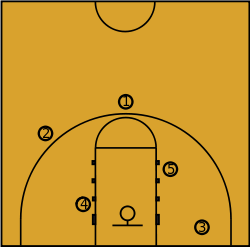Small forward
The small forward (SF), also known as the three, is one of the five positions in a regulation basketball game.[1] Small forwards are typically shorter, quicker, and leaner than power forwards and centers but taller, larger, and stronger than either of the guard positions.[1]
.jpg)
The small forward is considered to be perhaps the most versatile of the five main basketball positions.[2] In the NBA, small forwards generally range from 6' 6" (1.98 m) to 6' 8" (2.03 m) without shoes; in the WNBA, they are usually between 5' 10" (1.78 m) to 6' 1" (1.85 m).
Small forwards are responsible for scoring points and defending, and often are secondary or tertiary rebounders behind the power forward and center. In professional basketball, some have considerable passing responsibilities, and many are prolific scorers.[3]
The styles with which small forwards score vary widely. Some are very accurate shooters, and some prefer to initiate physical contact with opposing players, while others are primarily slashers who also possess jump shots. In some cases, small forwards position on the baseline; in other cases, they operate as off-ball specialists. The defensive specialists among them are notably versatile, often being able to guard multiple positions using their size, speed, and strength.
Small forwards inducted in the Naismith Memorial Basketball Hall of Fame include Julius Erving, Cheryl Miller, Larry Bird, Sheryl Swoopes, James Worthy, Elgin Baylor, Scottie Pippen, Dominique Wilkins, and Rick Barry.
References
- "Basketball 101: Basketball Positions Explained". Dick's Sporting Goods. Retrieved May 13, 2020.
- Recruiting Nation (November 28, 2006). "Versatility is key for small forwards". ESPN.
- "NBA.com - Players and Positions". www.nba.com.
